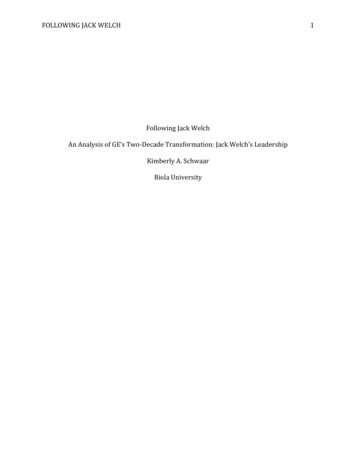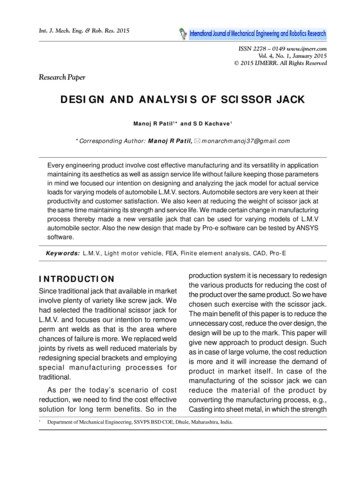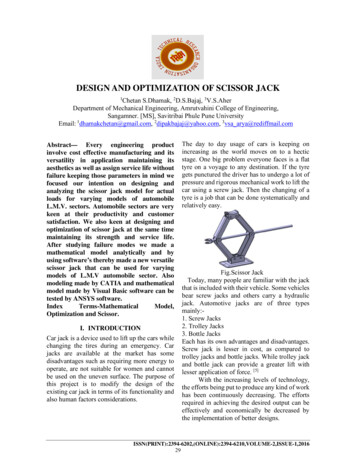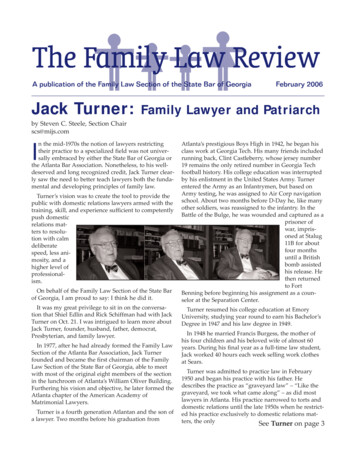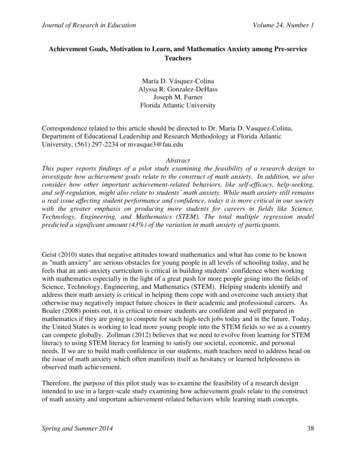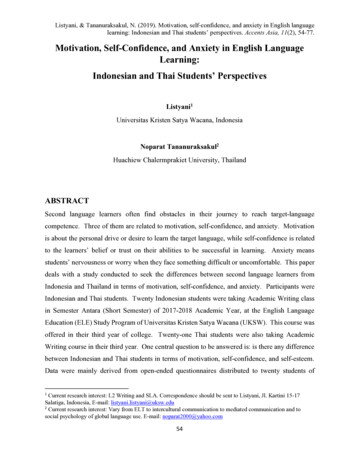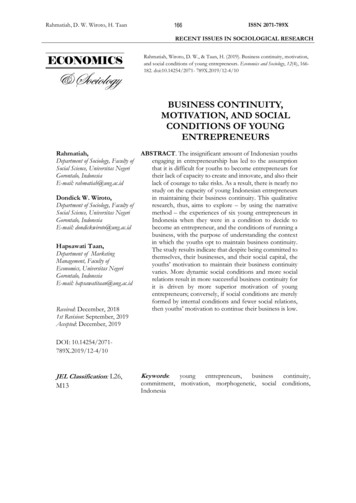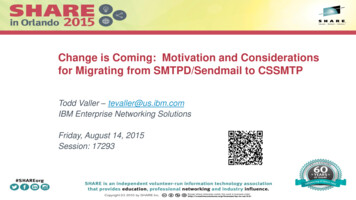
Transcription
The University of ChicagoGraduate School of BusinessJack WelchAnd the Motivation of.Bus 399-81Power & PoliticsProf. Richard LarrickMichael DulbergJudson PaschenSteven SprindisSacha Stawski
Michael DulbergJudson PaschenSteven SprindisSacha StawskiTABLE OF CONTENTSTABLE OF CONTENTS1MAIN BODY OF ANALYSISHypothesisIntroductionGoals and usion2236101314APPENDIX / ATTACHMENTSAppendix 1 - GE - The companyAppendix 2 - GE's Business PortfolioAppendix 3 - GE ValuesAppendix 4 - Work-Out - GE's Culture of LearningAppendix 5 - Extract from the 1996 Letter to Share Owners on Six SigmaAppendix 6 - GE Growth ModelAppendix 7 - The Performance StoryAppendix 8 - The Human StoryAppendix 9 - Changes in GE's Business Portfolio between 1981 and 1992Appendix 10 - The GE Transformation & Earning Profile with Cost ReductionsAppendix 11 - GE Organization 1981Appendix 12 - GE Organization 1992Appendix 13 - GE Organization 199316171819202122232425262728Bibliography291
Michael DulbergJudson PaschenSteven SprindisSacha StawskiHypothesisJack Welch has made General Electric Corporation (GE) into one of the world’s most successful companies.Through the use of goal setting, empowerment, and communication Welch transformed a complacent behemothinto an energized company ready to face world competition. Through an analysis of the techniques employed byWelch one can gain a better understanding of how to motivate outstanding performance in any organization.IntroductionWhen Jack Welch became CEO of GE in 1981, he set out to reenergize one of America’s largest companies (seeAppendix for GE company and product background information). Through a revision of GE’s mission and values(see Appendix), Jack Welch grew GE from a 24 billion company to into a 74 billion company, ready to facecompetitors and future challenges. Welch realigned goals and motivation, forcing managers to stretch to previouslyunknown limits. Any company not number one or two in their industry was divested or closed and though sometimesperceived to be a destroyer, he restructured GE into one of the world’s most staid corporations (see appendix for adetailed outline of the human story, the performance and divestiture/acquisitions story).Jack Welch’s management and motivation approach included three main areas:1.) Goal setting and preparing the company on a corporate level for its competitive challenges;2.) Empowering employees at all levels of the organization; and3.) Communicating his new goals and visions through the entire organization, using such tools as extensive training0programs, newly formed teams and 360 review processes.Different aspects of Jack Welch’s management tactics, in terms of motivating employees to bring about change,can be compared and contrasted with some of the cases analyzed during this quarter.These includeempowerment tactics used by Anita Roddick; “de-powerment” tactics used by Lyndon Johnson (LBJ); a reduction ofbureaucracy and secrecy, as well as an opening of communication channels, such as advocated by Kissinger;issues related to benefiting millions at the cost of thousands and acting for the achievement of some greater “good”,as discussed as part of the Robert Moses case; and communication and mass motivation issues as discussed inthe Xerox cases. Some of Welch’s other tactics can be directly related to topics discussed by Pfeffer, Cialdini and2
Michael DulbergJudson PaschenSteven SprindisSacha Stawskiothers, including an analysis of resources, sources of power, allies, locations within communication networks,reciprocation, formal authority, reputation, and performanceGoals & CompetitionAn underlying theme for Jack Welch’s tenure as CEO of GE was his use of goal setting to motivate higher levels ofachievement throughout the company. Welch set company wide goals, as well as specific performance objectivesfor individual companies and divisions. He often supplemented his goal setting by creating a sense of competitionwithin the organization, as well as against all competitors.Early on in Jack Welch’s career with GE, he exercised the use of goals and competition to drive above averageperformance. In 1968, at the age of thirty-three, Welch was promoted to the position of General Manager of GE’sLEXAN and NORYL plastics lines. His goal was to convince the market that both Lexan and Noryl could be used asreplacements for more traditional materials such as steel or glass.Typical GE protocol would have been toseparate the two lines and to position each for different markets so that no sales-territory-overlaps occurred.Bucking the old protocol, Welch told each group of sales people to attack the entire market and compete head-tohead. The strategy worked well for all parties. With Welch at the helm, GE Plastics earnings grew at 34% annually,compounded revenues in 1991 reached 4.7 billion and employees felt they were part of a winning, competitiveteam.Similarly, in 1980, when Jack Welch was elected to the position of CEO for GE, he continued his competitivestrategy to motivate performance in business units by requiring them achieve either number one or number twostatus in terms of market share in their respective fields. Many of GE’s businesses were already number one ofnumber two in their market areas and yet Welch and his management team continued to set goals, which would notonly keep them in those positions, but which would further grow their lead.Constantly striving to stay ahead of his competitors stokes Welch’s competitive fires. To achieve GE’s leadershipposition and to drive constant growth, Welch required goals and stretch-goals to be set throughout the organization.thHis stretch-goal philosophy developed from his readings of Johannes von Moltke, a 19 century Prussian generalwho outlined strategy as something with a simple, far reaching set of goals which could be achieved through adynamic organization not limited by strike guidelines. Welch preached a philosophy he called “planful opportunism,”3
Michael DulbergJudson PaschenSteven SprindisSacha Stawskiwhereby GE employees were given an over-reaching stretch-goal and permitted to do whatever it took to reach thetarget. He was able to demonstrate the success of “planful opportunism” with the expansion of LEXAN into theworld market. In the early 70’s LEXAN was only produced and marketed in the U.S. Welch created a stretch-goalof dramatically expanding LEXAN’s sales into the world market. He secured the necessary 55 million funding tobuild a plant in Holland and soon thereafter succeeded in growing global sales significantly. The stretch-goalsucceeded, and in 1977 GE generated 26% of its revenues overseas. Not only has Jack Welch demonstrated“planful opportunism”, but many of his senior leaders have chosen to adhere to the same philosophy.Welch continued to use stretch goals to drive performance throughout the company. In one instance, Welchchallenged John Trani, the head of GE's Milwaukee based GEMS unit, to increase production speed by a factor offive. Trani's pursuit of this goal, while never quite reaching it, resulted in strong growth in both production and sales.In another example, Welch required the newly hired head of productivity, William Sheeran, to achieve 5% annualproductivity. Sheeran never attained the lofty goal, however his efforts resulted in increasing productivity to over2%. Finally, Welch used the same technique in an effort to improve product quality. Welch introduced GE to SixSigma, a defect reduction program. GE had been operating at 3.5 sigmas, but that wasn't enough for Welch, hewanted six sigmas (nearly twice the national standard). (See Appendix for additional information on quality and SixSigma). In all these cases, Welch consistently set far reaching goals in an attempt to move the company in hedirection he wanted. While not all goals may be reached, Welch reinforced the notion that advancing towards thosegoals was still considered success and rewarded managers accordingly1.Another way of looking at Jack Welch’s attitude towards management and motivation in terms of goal setting maybe compared to what is often referred to as “the boiling frog syndrome”. When a frog is placed in a pot of water inwhich the heat is slowly turned up, it will not recognize the rising temperate, remain complacent and eventually boilto death. Analogously, Welch sees GE as being the frog placed in the world pot of water. The water temperaturearound GE is slowing rising and GE is getting hotter. If GE does not react to the temperature increases related tocompetition, it will boil to death as does the frog. If GE leads the market however, throws itself right into the pot ofboiling water, it will jump right back out, just like a frog would do, if thrown directly into a pot of boiling water. While1“With the push for quality has come a new warrior class within the company: Green Belts, Black Belts and Master Black Belts– the new management samurai of global competition If you don’t have a belt, you won’t get promoted [and] Welch hastied 40 percent of each manager’s bonus to progress toward quality results.”4
Michael DulbergJudson PaschenSteven SprindisSacha Stawskiothers may sit and wait complacently, slowly letting the heat rise around them, Jack Welch prefers throwing GE rightinto its challenges, shocking the system and forcing immediate reactions.“The people with whom I have been associated have worked hard, enjoyed it more, although not alwaysinitially, and in the end, gained increased self respect from accomplishing more than they previously thought2possible.”Welch realized that he could motivate higher levels of performance by setting goals that were much higher than themanagers would have set for themselves. These “stretch-goals” often caused the managers to outperform theiroriginal targets. The phenomenon that helped increase performance was the “slope of satisfaction” joined withinternal competition focussed on gaining a leadership position in world markets.The slope of satisfaction (pictured in the diagram below) refers to the incremental level of satisfaction a persongains for each additional unit of effort towards a goal. The slope increases as the person approaches the goal.Therefore, as a person gets close to reaching a goal he is more motivated to try to close the gap between thecurrent level of performance and the target. Furthermore, he is likely to continue striving for the goal because theincremental satisfaction gained is thought to be worth the additional effort. However, if the goal is seeminglyunachievable, the likelihood of the person undertaking or completing the task is reduced. Relief and stress oftenaccompany goal setting. Relief is felt if the goal is achieved, but stress is encountered while trying to reach the goalor if the goal is not reached.2The Washington Post, March 28, 1997, Talking Management with Chairman Welch Control Your Destiny of Someone Else Will, Tichy and Sherman, 19935
Michael DulbergJudson PaschenSteven SprindisSacha StawskiStretch GoalNormal GoalBAStartSlope of satisfaction: a person starts toward his goal at the bottom left end of the curve moving upward and tothe right toward the stretch goal. The slope of satisfaction can be demonstrated by noting that the level ofsatisfaction (distance on the Y axis) between points A and B is equal to the level of satisfaction between pointB and the Normal Goal. However, the effort exerted (distance on the x axis) to get from point A to B is muchgreater than the effort exerted to get from point B to the Normal Goal. Therefore, as a person gets closer to agoal the incremental satisfaction increases for each additional unit of effort. This helps drive a person to reachhis goals.Welch played upon these emotions in the application of his goal setting3. Because Welch set such extreme stretchgoals, he needed to incent effort toward these seemingly unattainable targets. He rewarded people by givingbonuses if they made great progress towards the goals, even if they did not reach them. This succeeded in drivingpeople to work beyond their original goals and even if they did not reach the stretch goals Welch often recognizedthem for superior performance. Employees realized that even though they often did not reach the stretch goals,they still performed at their highest possible level and therefore enjoyed personal satisfaction, (as understood byMaslow in his hierarchy of needs) in their attempts to reach the goals.EmpowermentWhen Welch took over GE, he had a vision of creating an organization where people at all levels could be heldresponsible for their own work, and in the end make decisions for the betterment of their job. The goal was not to3“Jack will chase you around the room, throwing arguments and objections at you Then you fight back until he lets you dowhat you want --- and it’s clear you’ll do everything you can to make it work. It’s a ritual. It’s like signing up.”6
Michael DulbergJudson PaschenSteven SprindisSacha Stawskicontrol workers, but instead to liberate them. Welch characterized this as creating a boundaryless organization inwhich empowered employees were self directed and motivated to effectively reach their goals.When Welch became the CEO of GE he found that the company was still organized the way it had been when GEwas founded near the turn of the century. Specifically, it was represented by an overwhelming nine layers ofmanagement between the shop floor and the CEO. This bureaucracy lead to an unresponsive, inward focusedcompany whose employees found great difficulty in communicating with one another. In fact, if GE’s massive coststructure was not dramatically restructured, analysts projected that GE would become unprofitable by the end of1982 (See Earnings Profile – With Cost Reductions diagram in appendix).Welch addressed this issue by eliminating whole layers of management (see appendix for 1981, 1992 &1993organizational charts), conso
Jack Welch’s management and motivation approach included three main areas: 1.) Goal setting and preparing the company on a corporate level for its competitive challenges; 2.) Empowering employees at all levels of the organization; and 3.) Communicating his new goals and visions through the entire organization, using such tools as extensive training programs, newly formed teams and 3600 .
